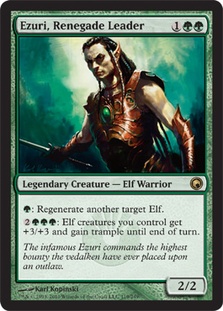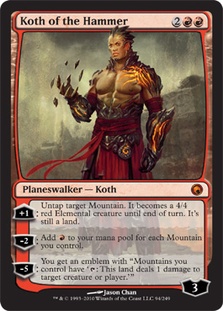Editor’s note: The software discussed in this article was programmed by a third party and is not supported by Wizards of the Coast or StarCityGames.com. Third party applications such as this may put your personal information at risk. Use with caution!
Update: Some disturbing information has come to light since publishing this article. Thus the author has asked to add this additional information to his article:
WARNING: Please be aware that the software talked about in this article is associated with a known malware distributor. It may not be safe to install on your computer. Some users of the previous version of this software were victims of theft at the hands of the software developer. This software is not endorsed by Wizards of the Coast or StarCityGames.com; you assume full responsibility for any loss that you incur by using this software.
For more information, see these two announcements from WotC: CBSBot Malicious Software, MTGO Library is CBSBot Re-Branded.
Hey everyone, I’m back this week to show you how to make a robot on Magic Online (MTGO). Unfortunately, you don’t get to hook up with a smoking hot chica, like when you make a baby; instead you have to endure at least a thirty minute software install and hours of research.
Before we get to that part, let’s trace my own journey into bot-making. It all started on a warm spring day. I was at my computer, working the classifieds on MTGO.
“Casual?”
I responded with, “Yes,” and accepted his trade request.
I spent about fifteen minutes looking through his collection and pulling things that were of interest to me.
I messaged him, “Did you see anything?”
“The trade session has been canceled.”
WTF! This guy just wasted fifteen minutes of my life, and I didn’t even get the courtesy of “Good-bye.”
It was this conversation (if you want to call it that) that inspired me to look for a bot. It’s not that I’m adverse to hard work; I actually crave it. When I was sixteen, I worked two jobs — by day, I was a whiz kid computer tech, and by night I laid tile with my brothers in what would become the family restaurant. My teen years were filled with the tension of my Father’s insatiable vision of progress and my personal ambitions to succeed. I wanted to make my pops happy and still succeed myself, so I learned the art of balancing my focus and working smarter.
If you read
last week’s article
you might have noticed how much of a pain in the arse it was to trade on Magic Online. I knew that the smartest way do this was to get a bot going. The question was, “How do I do that?” My initial instinct was to have one coded, but my initial instinct always wants the uber-best, and it isn’t always practical. I started to ask around, and there was only one recommendation.
There are other ways to get a bot going on MTGO; I’m not going to talk about those ways because I don’t know their specifics. MTGO Library has met my needs, and I don’t see any reason not to use it. I’m going to go through the setup of a MTGO Library bot, but before I do that, let’s see if you’ve got what it takes.
If you want to venture into the world of MTGO bot-making, you’ll need four things.
A blank Magic Online account
— you can buy one of these for $10. Keep in mind there are rules about entering tournaments with multiple accounts and such. Don’t be an idiot; follow the rules.
A spare computer
— I’m running an old Craptop (which is the technical term for Crappy Laptop) with a “Yo! MTG Taps!” sticker on the lid. This isn’t the optimal setup; typically you want a server with ESXI and multiple virtual machines. I know; I just plunged into the depth of nerdhood, but don’t worry; we’re not going get that deep.
A fat stack of dollar bills
— the software doesn’t cost money to set up, which is great, but you need to give the bot tickets, so that it can buy cards and fill itself up. I’ll talk about just how much money you need a little later on.
A lot of free time
— I don’t have this, but like I said, I learned to work smart, and I’m one of the best at figuring out which cards I want to buy and which cards I need sell. You’ll need this free time for watching trends and programming your bot’s pricing accordingly.
Once you have those four things, you’re ready to rock. Let’s get things started.
The first thing that you have to do when setting up the bot is to register an account on the MTGO Library website. I hate it when websites make you register for the site before you can download the software. This usually means that they send you crappy advertisements for the rest of your life; fortunately this site wasn’t like this. There’s a purpose for the registration: the software has two sides, there’s a software side that runs on the bot computer and a web-based control panel that runs on MTGO Library servers. The client software controls your computer to make the trades, and the web-based control panel keeps track of your trades and your fees.
After registering for a user account, you need to download the software and install it on your computer. You also need to install the latest version on MTGO. There’s a bunch of technical mumbo jumbo that you have to do before actually hitting the “Launch” button on the bot. Be sure to read the ML Bot Manual before you actually hit launch. If you hate instructions like me, you can just follow along with my walkthrough, and you’ll have a bot up and running in no time!
The Walkthrough
I’m going to give you a quick walkthrough for setting up the bot. I do recommend that you read the manual at some point, since I’ll be skipping stuff that isn’t necessary to get the bot running, but the settings may be useful to you. I’ll highlight the optimum setting for making the most profit.
There are a billion options for setting up your bot. Today we’re going to focus on building a tradition “one-stop-shop-bot” — I took that line from my favorite Dr. Seuss book,
Bots on Pot.
The bot that we’re going to configure will buy and sell cards based on the pricing that you set and/or based on a universal price list from MTGO Library.
When you launch the bot software, you’ll be asked which “bot” you want. For our purposes, we’re going to choose the pro bot, because we’re Pros, obviously. It’s also because the “lite” bot is more geared toward selling bulk; I’m sure you’ve seen those bots that say, “Selling 40 uncommons for a ticket.” These are based on the “lite” version of this bot. I hear that these pull a decent profit, and I’ll be setting some of these up in the future. After you click the pro bot, you’ll be presented with some choices.
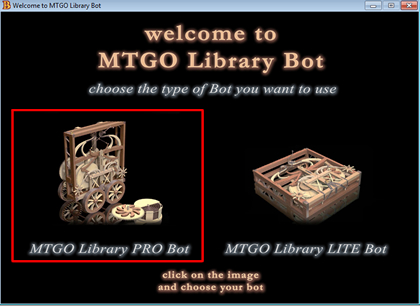
We’ll look at a base configuration to get your bot going. You can choose to tune the bot however you want. I’ll also give you some notes to keep in mind. Let’s look at the highlights from the “General Tab.”
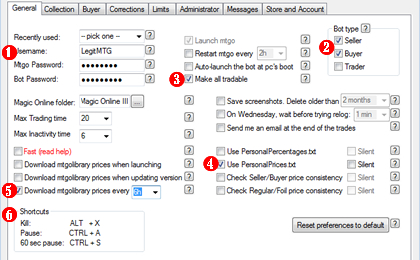
1)     This is where you‘ll enter your MTGO login name; this should be the same as your bot user name on the MTGO Library website. You also must enter you MTGO password and your Bot password from the MTGO Library website.
2)Â Â Â Â Â We’re going to make this bot a buyer and seller. When you become a baller, and you’re bringing in the tickets by the truckload, you can open multiple “buy” bots, which only buy cards. This would free up your selling bot and let you process multiple customers at once. Since we’re small potatoes right now, we’ll make this bot do everything.
3)Â Â Â Â Â This tells the bot to make everything tradable; you want this with the buy/sell bot model because it makes the things that you buy available to be sold right away.
4)Â Â Â Â Â This is the file that dreams are made of. I’ll show you how to make an entry in the “PersonalPrices.txt” file in a minute; for now, just do what you’re told, and check the box.
5)Â Â Â Â Â This tells the bot to update its prices. I tell mine to update every six hours. I want the latest info, so that I don’t get jacked by bot raiders. You should do the same.
6)     Pay attention to these commands. I stupidly didn’t notice them when I set up the bot for the first time, and I had to hit the power button on my computer to gain control of it again. Then I realized that you could just hit “CTRL+A” to pause the bot — I guess reading is tech.
Collection Tab
This is where you tell the bot what to buy. You can check different sets and specify how many of each rarity that you want the bot to buy for each set. I use this feature to great advantage. For example, I unchecked all the sets in the Alara block so that my bot wouldn’t buy this stuff. The prices are still cooling down from the cards being in Standard, and people are looking to dump these cards. I didn’t want to be caught holding the bag on them, so I simply unchecked them.
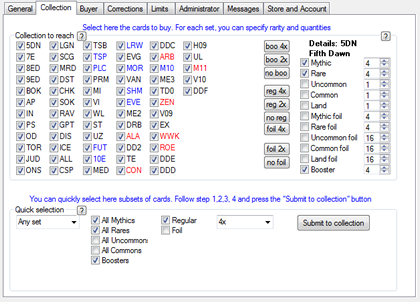
The best way to start is to select everything and refine later based on your goals. You can use the “Quick Selection” feature to give a blanket command for buying. We’ll use three of these “Quick Selection” commands to get you started.

Select “All Sets,” and then check the following boxes: “All Mythics,” “All Rares,” “Boosters,” then select “4x,” and check “Regular.” This tells your bot to buy up to four of all mythics, rares, and booster packs. You may want to set up the bot to buy up to twelve of the latest set, so that you can supply drafters (a.k.a. the crackheads of Magic).

Select “All Sets,” and then check the following boxes: “All Uncommons,” “All Commons,” “Regular,” and then select “don’t buy (0x).” This tells your bot not to buy commons or uncommons. Don’t get me wrong; your bot should be stocked with plenty of commons and uncommons; you’ll need them for Constructed players and set builders. It’s also a convenient way for your customers to cash in on their bot credit. I recommend that you buy or trade for these yourself at bulk rates. Your bot will use the price guide and will pay way too much for the commons and uncommons.

Select “All Sets,” and then check the following boxes: “All Mythics,” “All Rares,” “All Uncommons,” “All Commons,” “Foil,” and then select “don’t buy (0x).” This tells your bot not to buy foils. Foils are a lucrative business on MTGO, but like above, I recommend that you manually buy foils to stock your bot.
Messages Tab
These are the messages that your bot will use to communicate to the MTGO community. I’ve found that you get better results when you add your sell prices to the “Classifieds” field. Be sure to check “Prefix [BUSY]/[OPEN]…” and “Trading Room Message.” This will give you the most exposure.
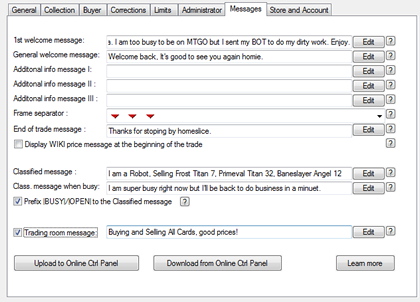
Setting Your Own Pricing
Your bot is ready to rock and roll now; you can hit “Launch,” and it’ll start buying and selling cards. The problem is that it’s not tuned for completive sales or profit. Cards on MTGO are in constant flux, especially Standard cards. If you don’t tune your bot, then you won’t be able to compete with the other bots. The best thing to do is to set pricing for the hottest cards (these are typically the cards that are listed by multiple bots in the classifieds) and let the bot price the rest. Specific pricing is set up in the PersonalPrices.txt file, which should be located here:
C:Program FilesMTGOLibraryMTGO Library BotPersonalPrices.txt
Open this file, and list the cards based on the sample entry. I use a spreadsheet to keep track of pricing and then export the spreadsheet as a CSV file; then I convert the commas to semicolons. Yeah, that method is a lot of work, but I like the feel of a spreadsheet better.
You can also use this file to tell the bot which cards not to buy; you can do this by making the last two entries “0.” This means, “Don’t buy this card, regular or foil.” I recommend that you do this for all the bulk rares in the current Standard sets; you can then acquire bulk at true bulk pricing and stock your bot.
Here are some examples of PersonalPrices.txt entries.
SETNAME;CARDNAME;SELLING PRICE;FOIL SELLING PRICE;BUYING PRICE;FOIL BUYING PRICE;QUANTITY REGULAR;QUANTITY FOIL
M11;Jinxed Idol ;0;0;0;0;0;0
This entry says: don’t buy M11 Jinxed Idol. This is signified by the two “0s” at the end of the entry. It also says to sell them for “0” tickets; this should only be done on a blank bot because if you currently have a Jinxed Idol in your bot, then it’ll “sell” it for “0” tickets. You can also set the selling price, but this becomes tedious if you set pricing for all your bulk rares.
SETNAME;CARDNAME;SELLING PRICE;FOIL SELLING PRICE;BUYING PRICE;FOIL BUYING PRICE;QUANTITY REGULAR;QUANTITY FOIL
M11;Frost Titan ;7;12;6;0;8;0
This entry says to buy up to eight regular Frost Titans at six tickets each. It says to sell them at seven tickets or twelve if foil and says not to buy foil Frost Titans.
You need to do your research and build a strong PersonalPrices.txt file. This is where most of your profit will be realized. After you’ve built the PersonalPrices.txt file, save it; you’re almost ready to bring your bot to life.
Finishing Touches
The final step is to add tickets to your bot’s MTGO account. You’ll need to find a place to buy tickets cheap. I get mine between $.90 and $.92 per ticket from various friends. I think you can get them even cheaper, but I don’t mind hooking my friends up in exchange for bot food (a.k.a. money). In the beginning, your bot will eat up like
Jay Boosh
at the Thanksgiving dinner table.
I spent a lot of time trading before I actually started the bot, so the final numbers will be a little bit skewed. I transferred about nine hundred bulk rares and tons of playable Standard commons and uncommons to the bot. After that I started to keep track. Here’s the ledger that I’ve been using to keep track of how much I’ve been dumping into my bot.
Bought a Collection        18
Bought an Account         9.99
Tickets (42)Â Â Â Â Â Â Â Â 39
Tickets (100)Â Â Â Â Â Â 92
Cards    18
Tickets (55)Â Â Â Â Â Â Â Â 50.6
Cards    10
Cards    140
Tickets (88)Â Â Â Â Â Â Â Â 80.96
Total $458.55
This is my total investment so far, and my bot is finally reaching a point of self-sustaining momentum. This means that my bot is selling as much as it’s buying. I’ve yet to see any profit; I think that’s still pretty far away, but I’m seeing progress. Before I leave the topic of bots, I should probably tell you about the fees.
Fees
The MTGO Library charges you 3.5% on every transaction; yeah this guy probably drives a freakin’ Maserati. You also get charged .20 every time that you update the price guide. Keep these fees in mind when you’re setting your pricing.
I hope that this has been helpful. I’d be happy to answer any questions about bots; just leave them in the forum; there’s still a lot to talk about. I recommend that you read the full user guide before setting a bot up for yourself.
Pre-States Buzz
You might have noticed that I haven’t been including a “Stock Tips” section lately. I’m sorry if you miss that; I’m still playing with the format of these articles, and I’m not sure that the stock tips were the best way to end the articles. I’d really dig some feedback on this topic. Last week Summa from the forums suggested that I add a little something for the “Paper-only folks,” a.k.a. people who don’t care about MTGO. I thought that this was a great idea, so I wanted to talk about three cards that are getting a lot of pre-States (State Championships) talk.
This guy has become a staple in the Standard Elf build. You can pick these guys up at the trade tables for between $1-2, and you can easily trade them at $4 to people who are trying to build this deck (true story). I don’t expect this guy’s actual price to get much higher than $4. Eldrazi Monument will be the card that spikes in price in the deck, since it’s a mythic.
I couldn’t keep Koths in my binder in the weeks leading up to States. People were throwing their Elspeths at me and begging for Koth. His price still has a lot of terrain to tread. He seems fairly strong against U/W Control but pretty weak against Titans. Watch for metagame shifts that will continue to drive the demand for Koth. If nothing else, I’ve been finding that people are more eager to build with Koth than any other planeswalker out of SOM. If you have the opportunity to pick these up in a trade, I recommend it.

This guy is shooting up like a bullet. The Standard metagame is ruled by Primeval Titan, and it turns out that Frost Titan is the best answer to him (and the other Titans for that matter). He was the lowest priced Titan, but I don’t expect that to last long. I’ve been watching his price on MTGO, and he’s gone from 3.5 to 7 tickets in the last three days.
That’s all I have for this week. I’ll see you next week. Thanks for reading.
Jonathan Medina

